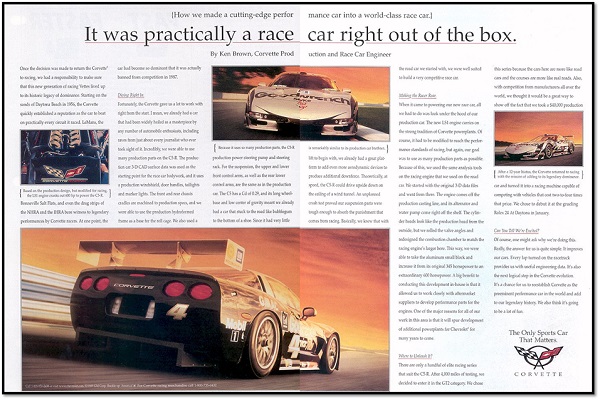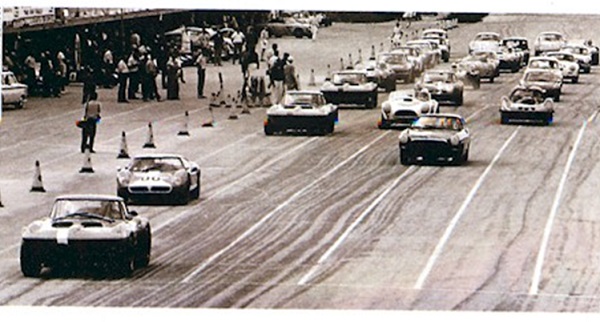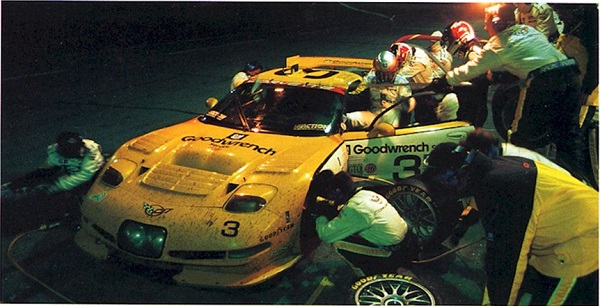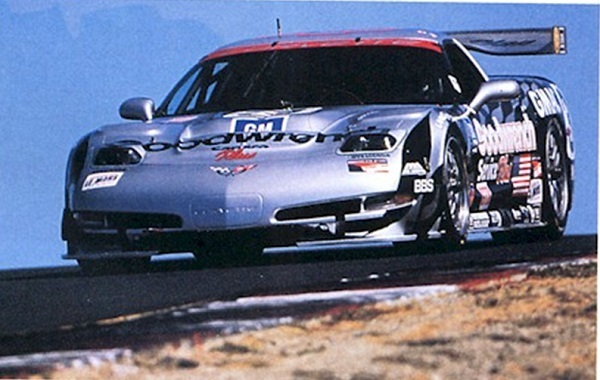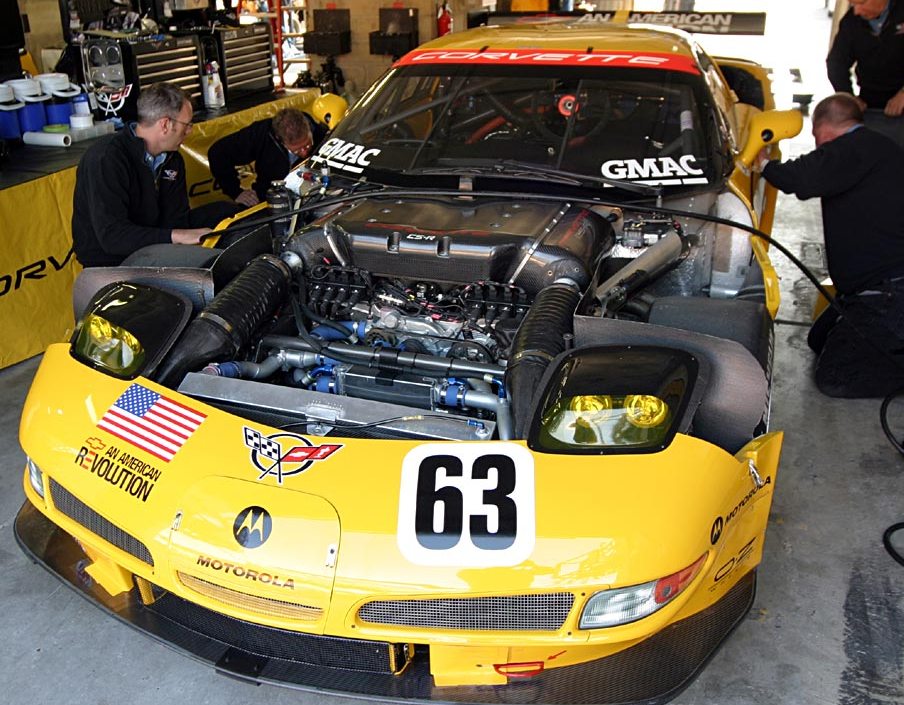Corvette History through Ads: The C5R and Factory Racing, Part 1
For the next few weeks, Corvette History through Ads will focus on one of the most important parts of the Corvette’s history; so important in fact that Chevrolet devoted most of their advertising budget (other than a few ads promoting the new Fixed Roof Coupe in 1999 and the Z06 in 2001) telling its story. Beginning shortly after the introduction of the fifth generation Corvette, for the first time in the Corvette’s history there would be a factory sponsored racing program. No longer would factory involvement be the clandestine, back door effort that had been in place since GM unofficially banned racing in support of the 1957 Automobile Manufacturers Association “gentleman’s agreement” to prohibit direct involvement in racing. Then in 1963, shortly after Zora Arkus-Duntov built his legendary Grand Sport, GM’s chairman realized that the spirit of the AMA agreement was routinely being ignored and issued an official pronouncement that all racing activities within the corporation would be immediately stopped. Effectively this decree halted the unofficial support GM had been giving Corvette race teams “under the table” since the AMA’s 1957 ban. So after almost forty years of factory racing abstinence there was a lot of pent-up desire as well as excitement both within the Corvette team and from loyal Corvette enthusiasts to have the factory support a racing team.
The marketing department were not the only ones within GM to recognize the sales opportunity that successful racing would foster. Even before the Corvette existed automobile manufacturers understood the importance of racing, giving rise to the axiom “win on Sunday – sell on Monday.” And early on, in the Corvette’s case there was even more at stake. As early as 1956 the General Manager of Chevrolet, Ed Cole, realized that the Corvette needed to establish its reputation as a true, performance-based sports car if it were going to survive. The only way to establish that reputation was on the track, to go head to head with the competition and win. So when the AMA banned “direct involvement” in racing in 1957 the only alternative to establish the Corvette’s performance pedigree was for Chevrolet executives to close their eyes to the “indirect” back door assistance. This indirect help not only provided engineering assistance to private teams like Briggs Cunningham’s, who mounted a three car attack on LeMans in 1960, but also went as far as filming a thirty minute documentary on the success of the LeMans campaign (just below). The #3 car won its class and helped secure the Corvette’s performance reputation.

When the GM chairman’s official ban went into effect in 1963 there was major disappointment both inside and outside GM. No one was more discouraged than the chief engineer of the Corvette, Zora Arkus-Duntov. The ban meant that his purpose built Grand Sports could not spearhead a factory effort to win Sebring and Le Mans. Today those Corvettes are the most coveted and expensive of all Corvettes. And the official ban also muddied the waters for the 199 Z06s produced in 1963. The impressive Z06, a thinly disguised production race car, was discontinued after only one year until its reintroduction in 2001, not coincidentally, just following the Corvette’s return to racing.
Even though banned from factory involvement in racing it did not prevent GM from continuing to develop some of the fastest American production cars and most years the fastest production car in America was the Corvette. In fact in the late 1960’s and early 1970’s Corvette produced a factory race car that “technically” could be ordered through a Chevrolet dealership. Those cars are recognized by their special engine package RPO code, the legendary L88’s and the ZR1’s and ZR2’s. With rare exception anyone ordering any one of these cars was doing so with the intent to race it.
What a chairman’s mandate could not completely kill, the gas crisis and the resultant strict fuel economy standards managed almost overnight, at least for several years. Performance was sacrificed and the high horsepower of the 60’s and early 70’s was slashed almost in half from 1974 through the 1980’s. However, as technology improved in engine design and management, performance slowly began to return with the introduction of the ZR1 in 1990. The ZR1 received unprecedented rave reviews and customers were paying premiums to get one of the special cars. For the first time the Corvette was considered in the same class as Europe’s best sports cars. The ZR1 helped to increase demand for performance cars. But the fourth generation Corvette was due to be replaced by the time the ZR1 was introduced so the fifth generation Corvette would have to carry on and even improve on the ZR1’s performance. And once demand began to increase it revived the “sell on Monday” axiom. The thinking behind the C5 became, “since we are designing a completely new Corvette, why not design a car that could win on the track as well as in showrooms?” The seed was planted in the very fertile minds of the Corvette engineers and designers.
Sponsoring a factory-backed racing team was no small undertaking, requiring more than just throwing money at it. It needed the full support of the engineering and development team. It required testing and more testing in every condition. The car not only had to be the best in terms of speed but also handling, braking and suspension. And an even more important ingredient was reliability. The only objective was building a car that could not only benefit and improve the production models but to build a car that would absolutely dominate on the track. Anything less was defeat. But the designers and engineers inside GM were more than willing to take on the challenge. And though not well known, the first year the C5 was introduced, testing a race car version also began.
As the program evolved and information began to leak regarding the program, the marketing department wanted to take full advantage of Corvette’s factory racing effort and involve the legions of Corvette enthusiasts in the journey. Thus GM devoted the majority of the Corvette’s marketing budget to promoting the cars and the program.
Looking back, Doug Douchard, former director of the Corvette Racing Program and now General Manager of Hendrick Motorsports, explained the benefits of a factory backed program. “The C5-R will be remembered like no other Corvette in history because it was the first ever official factory Corvette race car. We’ve not only improved the breed for the production car, but the racing program has proved tremendously valuable for what it has done to energize the corporation from the inside. From the moment of the car’s first test at Grattan Raceway in 1997, it was destined to do great things.”
Part of the marketing strategy was a series of informational ads which tied the production car to the factory race cars. Ken Brown, a Corvette engineer, did one of the first two page ads in which he detailed the production parts used in the race car, everything from the aerodynamic body design, the durable LS1 engine, the hydroformed frame and even the upper and lower suspension control arms. He ends explaining why GM is fielding a factory backed racing team: “It improves our cars… it’s the next logical step in Corvette evolution. It’s our chance to reestablish the Corvette as the preeminent performance car in the world.” Based on the success of the C5-R program and the evolution of the Corvette, it appears that the effort has more than paid off.
Part two next week…

